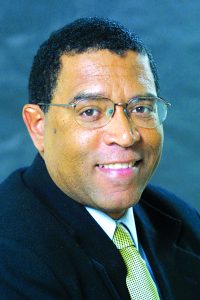In what marked the beginning of an unexpected and unsettling experience, Brown said the orderlies transferring her from her midwives patient program to the OB-GYN department ahead of delivery had an ill-timed conversation.
“They were talking like they were at happy hour and like I was a sack of potatoes, just like something else they had to check off for the day,” Brown said.
But Brown’s experience was anything but casual: she had complications after delivery that required three emergency surgeries.
Her case was considered a “maternal near-miss,” which the World Health Organization defines as a woman who almost dies due to issues during pregnancy, delivery or within 42 days after pregnancy.
Brown’s experience underscores a persistent discrepancy among black mothers, whose mortality rate is far higher than that for the general population. Several factors, including racism, are behind that disparity, according to health experts.
Some members of Congress last week launched an initiative to combat this long-standing yet recently-publicized issue.
House Majority Leader Steny Hoyer, D-Mechanicsville, and 57 other lawmakers formed the Black Maternal Health Caucus, which is aimed at encouraging culturally relevant, evidence-based policies to support black mothers.
Hoyer said he wanted “to make clear that the House ought to approach issues of healthcare access with a recognition of the unacceptable and tragic disparities for women of color and their children.”
Founded by Reps. Alma Adams, D-North Carolina, and Lauren Underwood, D-Illinois, the Black Maternal Health Caucus seeks to promote better black maternal health outcomes.
“The status quo is intolerable, we must come together to reverse current trends and achieve optimal birth outcomes for all families,” Underwood said in a statement.
As Brown’s sudden change in birth plan illustrates, a number of factors related to the birth process remain out of a patient’s control.
Thinking about the type of care a mother-to-be wants can help ensure appropriate measures are taken, said Noelene K. Jeffers, a certified nurse midwife and Ph.D. candidate at Johns Hopkins University.
“It’s really important to consider carefully the provider that you’re choosing to make sure that you choose either an OB-GYN or a midwife who you can have a comfortable, respectful, collaborative relationship with and who will help you to make informed decisions,” Jeffers said.
Despite an overall improvement in life expectancy in the United States, there are still noticeable disparities among racial minority groups, said Stephen B. Thomas, director of the Maryland Center for Health Equity.
On average, 36 women in the District of Columbia and 24 women in Maryland die for every 100,000 live births, while the overall national average recorded 20.7 maternal deaths, according to the United Health Foundation’s 2018 report on children and women’s health.
The black maternal mortality rate average is more than double the national average at 47.2. Maryland ranks lower, with an average of 40.5 black maternal deaths, while in the District the mortality rate among black mothers was a staggering 70.9 deaths per 100,000 live births, the analysis said.
In a country with the most expensive health care, more women die of complications from childbirth than in any other developed nation, according to the American College of Obstetricians and Gynecologists.
“We’re like the richest third-world country in the world and unfortunately, the burdens of race and history would be easy to ignore if they were not so well documented,” Thomas said of the death rate among black mothers.
Thomas, who is also a professor at the University of Maryland, said an understanding of the gap in life expectancy for black mothers can be broken down into three components: a broken healthcare system, patient preferences (that is, not wanting a midwife) and “what’s left is what we call a health disparity.”
Such a disparity is “a particular type of health difference that is closely linked with social, economic, and/or environmental disadvantage,” according to Healthy People, a federal website managed by the Department of Health and Human Services.
“It’s when you look between the lines, when you disentangle those lines by race, ethnicity — everyone is not benefiting,” Thomas said.
Acclaimed tennis player Serena Williams last year shared with Vogue the intense medical journey she went on following the birth of her child.
Williams said she alerted a nurse that she needed medical attention and the attendant initially thought the medication was confusing her, but Williams persisted. Eventually, tests revealed small blood clots in her lungs.
While Williams had the ability to self-advocate through a complicated process, Thomas added, “think of those black women who didn’t have that kind of agency to speak to power, who are now not here.”
Brown, who works at an education nonprofit, relied heavily on her husband for support after doctors were alarmed by her significant blood loss after delivery, which led to the three subsequent emergency surgeries.
During one of the surgeries, hospital staff failed to alert Brown’s husband, who was with their newborn, that she had been put under anesthesia again.
“Nobody called him and told him I was in surgery,” Brown said. “He said someone came and told him, ‘Your wife’s almost out of surgery’ and he was like, ‘When did she go back into surgery?’”
Even with the steady support of a partner, Brown said she witnessed faulty hospital procedures and policies. She filed a complaint with the hospital’s administration.
“When you’re at the peak of crisis that’s not the time to be dealing with their internal issues on things,” Brown noted. “So, there was a whole added element on top of the actual medical emergency.”
The hospital responded to Brown’s complaint and she said she was pleased with the response, encouraging the administration to do a formal review of her case to see what could be done differently. According to her doctor, Brown said, they did.
Typically, poor health and healthcare are associated with a person’s socioeconomic standing. In the cases of Williams and Brown, regardless of being two black women in their thirties with active support systems and careers, they encountered life-threatening birth complications.
Understanding that factors such as class, education and marital status have not lowered the disconcerting rates of black maternal mortality has encouraged health experts to acknowledge the influence of racism as a cause.
“Specifically thinking about race-based maternal-infant health disparities, the prevailing theory is that racism is the major underlying factor that contributes to these disparities,” Jeffers said.
For instance, a woman’s perception of the daily racism she experiences in her interpersonal relationships, which can include encounters with coworkers or strangers, is associated with premature birth, Jeffers added.
Also, Jeffers said women living in areas known to have higher amounts of explicit or implicit racism are at-risk for having babies with low birth weights.
“So there is quite a bit of evidence that indicates that racism and stress that comes with … racism, sort of dealing with that on a chronic everyday basis, is impacting maternal-infant healthcare,” Jeffers said.
Jeffers cited an example of structural racism continuing to affect black people: redlining, an unjust method used to prevent minorities from acquiring home-ownership loans, stifle their ability to relocate out of impoverished areas and ultimately uphold local racial segregation.
“When you have large amounts of segregation and, for example, black individuals are segregated into specific areas, then that can subsequently affect the access to quality healthcare institutions,” Jeffers said.
Thomas likens this nonstop, multifaceted wear and tear from the daily pressures of racial prejudice to incessantly revving an engine to the point of damage.
“If you were to sit in your car, turn your car on and press the accelerator to the floor and just let the engine rev up, that’s what’s described as what’s happening to black people in America,” Thomas said. “The foot never comes off the pedal.”
That is to say, when you are living in a society where the presence of racial prejudice is never-ending, few ways exist to avoid the stress of racism and thus, overcome health issues leading to disparities.
The National Partnership for Women & Families suggests policymakers address the issues of structural racism and racial discrimination in healthcare as well as expand protections for pregnant workers and health coverage for low-income insurance services like Medicaid to combat the maternal health crisis.
Furthermore, the organization calls for policies funding reliable community-based providers such as Planned Parenthood that provide basic yet critical reproductive health services.
“(Racial discrimination) can actually get under your skin and kill you. And that’s what we believe is happening with African Americans,” Thomas said.








































































